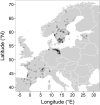Can size distributions of European lake fish communities be predicted by trophic positions of their fish species?
- PMID: 35845376
- PMCID: PMC9272069
- DOI: 10.1002/ece3.9087
Can size distributions of European lake fish communities be predicted by trophic positions of their fish species?
Abstract
An organism's body size plays an important role in ecological interactions such as predator-prey relationships. As predators are typically larger than their prey, this often leads to a strong positive relationship between body size and trophic position in aquatic ecosystems. The distribution of body sizes in a community can thus be an indicator of the strengths of predator-prey interactions. The aim of this study was to gain more insight into the relationship between fish body size distribution and trophic position in a wide range of European lakes. We used quantile regression to examine the relationship between fish species' trophic position and their log-transformed maximum body mass for 48 fish species found in 235 European lakes. Subsequently, we examined whether the slopes of the continuous community size distributions, estimated by maximum likelihood, were predicted by trophic position, predator-prey mass ratio (PPMR), or abundance (number per unit effort) of fish communities in these lakes. We found a positive linear relationship between species' maximum body mass and average trophic position in fishes only for the 75% quantile, contrasting our expectation that species' trophic position systematically increases with maximum body mass for fish species in European lakes. Consequently, the size spectrum slope was not related to the average community trophic position, but there were negative effects of community PPMR and total fish abundance on the size spectrum slope. We conclude that predator-prey interactions likely do not contribute strongly to shaping community size distributions in these lakes.
Keywords: body size; community size spectrum; ecological interactions; fish; predator–prey interactions; trophic level.
© 2022 The Authors. Ecology and Evolution published by John Wiley & Sons Ltd.
Figures



References
-
- Appelberg, M. , Berger, H.‐M. , Hesthagen, T. , Kleiven, E. , Kurkilahti, M. , Raitaniemi, J. , & Rask, M. (1995). Development and intercalibration of methods in nordic freshwater fish monitoring. Water Air and Soil Pollution, 85(2), 401–406. 10.1007/bf00476862 - DOI
-
- Arim, M. , Bozinovic, F. , & Marquet, P. A. (2007). On the relationship between trophic position, body mass and temperature: Reformulating the energy limitation hypothesis. Oikos, 116(9), 1524–1530. 10.1111/j.0030-1299.2007.15768.x - DOI
-
- Arranz, I. , Brucet, S. , Bartrons, M. , Garcia‐Comas, C. , & Benejam, L. (2021). Fish size spectra are affected by nutrient concentration and relative abundance of non‐native species across streams of the NE Iberian Peninsula. Science of the Total Environment, 795, 148792. 10.1016/j.scitotenv.2021.148792 - DOI - PubMed
-
- Arranz, I. , Hsieh, C.‐H. , Mehner, T. , & Brucet, S. (2019). Systematic deviations from linear size spectra of lake fish communities are correlated with predator‐prey interactions and lake‐use intensity. Oikos, 128(1), 33–44. 10.1111/oik.05355 - DOI
LinkOut - more resources
Full Text Sources
Research Materials

